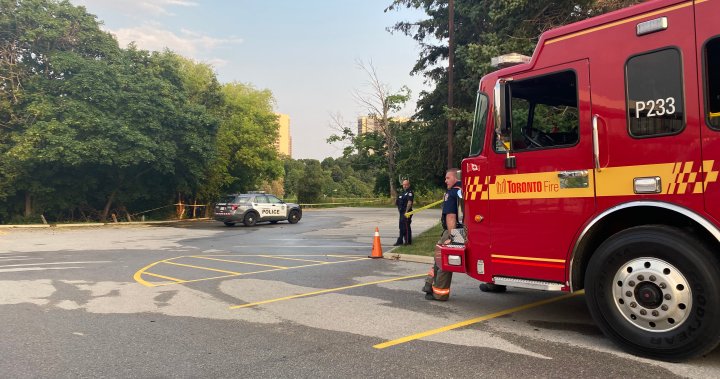The early morning blaze that tore through a homeless encampment in Toronto’s Don Valley yesterday has reignited urgent conversations about the city’s ongoing housing crisis and the safety risks faced by those living outdoors.
Firefighters responded to the scene shortly after 5 a.m., battling flames that had already consumed several makeshift shelters. Fortunately, no serious injuries were reported, though two individuals were treated for minor smoke inhalation at the site.
“What we’re seeing is the predictable outcome of forcing people to survive in increasingly desperate conditions,” says Diana Jackson, outreach coordinator with Toronto Street Support, who I spoke with at the scene. “When people have no options but to use candles, improvised heating, or cook over open flames, these dangers multiply.”
This marks the third significant encampment fire in Toronto this year, continuing a troubling pattern that has emergency services and housing advocates equally concerned.
Fire Inspector Sameer Patel told me the cause remains under investigation, but noted the inherent dangers present in encampments. “Combustible materials, makeshift heating solutions, and limited escape routes create high-risk scenarios,” Patel explained while crews secured the area.
The location, tucked into a wooded area near the Don Valley Parkway, highlights how many unhoused residents seek seclusion for safety and to avoid displacement. However, this isolation can delay emergency response times, creating additional hazards during crises.
City data indicates approximately 10,000 Torontonians currently experience homelessness on any given night, with shelter occupancy rates consistently above 98% throughout winter months. The shelter shortage has pushed more people into outdoor living situations despite the serious risks.
Walking through what remained of the encampment, I witnessed the stark reality of lost possessions – charred sleeping bags, melted tarps, and the few belongings people had managed to salvage. The human cost extends far beyond the material damage.
“I lost everything except what I’m wearing,” said Marcus, a 43-year-old camp resident who declined to share his last name. “Where am I supposed to go now? The shelters are full, and I’ve been on the housing waitlist for three years.”
Toronto’s Streets to Homes program has intensified outreach efforts following the fire, but the fundamental shortage of affordable housing continues to undermine these initiatives. The average wait time for subsidized housing in Toronto now exceeds seven years, according to the city’s own housing portal.
Councillor Ana Bailão, who chairs the Planning and Housing Committee, acknowledged the challenge in a statement: “This incident highlights the urgent need for accelerated housing solutions and better temporary supports. We’re working to expand shelter capacity while pursuing longer-term housing strategies.”
Community organizations have mobilized quickly, providing emergency supplies and support to those displaced by the fire. The Encampment Support Network distributed sleeping bags, warm clothing, and food packages within hours of the incident.
“We see this cycle repeat itself because the underlying issues remain unaddressed,” notes Dr. Stephen Hwang, director of the Centre for Urban Health Solutions at St. Michael’s Hospital. “The health impacts of homelessness are severe even without these acute crises, and fires compound the trauma people are already experiencing.”
The temperature dropped to -8°C last night, adding urgency to relocation efforts for those affected. Warming centers across the city have extended their hours, but capacity remains limited.
Fire prevention education has become an increasingly important component of outreach work, though advocates emphasize that such measures treat symptoms rather than causes.
“We can teach safer practices, but the real solution is housing,” Jackson emphasized. “No amount of fire safety training replaces the security of four walls and a roof.”
As cleanup continues today, the conversation among city officials, emergency services, and housing advocates centers on both immediate safety needs and systemic solutions. The incident serves as a stark reminder of the dangerous conditions faced by Toronto’s most vulnerable residents each day.
The city’s recently announced Housing Action Plan aims to create 65,000 new affordable housing units by 2030, but current progress falls significantly short of targets. Meanwhile, those without housing continue to face daily risks that most Torontonians will never experience.
For Marcus and others displaced by yesterday’s fire, the immediate challenge is finding somewhere safe to sleep tonight, while the larger question of sustainable housing solutions remains frustratingly distant on the horizon.







